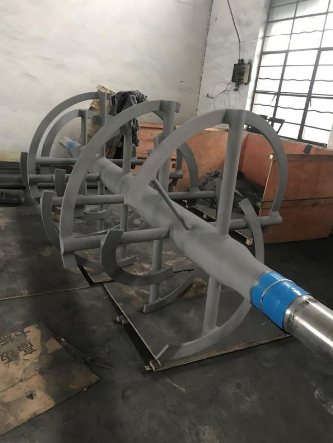

current position:Information and data>ribbon
The treatment methods often used in the current stirring equipment are: 1. Surface chrome plating, 2. Electrostatic spraying of Teflon, 3. Inlaid stainless steel or ceramic lining, 4. Surface nitriding or carburizing, etc. The main purpose of these methods is to achieve the effect of wear resistance, corrosion resistance and high temperature resistance, but each process can only achieve a one-sided effect.

Although chrome plating on the surface can play a role in corrosion resistance, the coating is very thin and has poor wear resistance, and as the country's supervision of chrome plating becomes stricter, the cost of electroplating has gradually increased. It needs 50-100 microns, and its wear resistance is more than 5 times that of chrome plating. If it is a special working condition with both corrosion and wear, select the appropriate coating material, and its comprehensive life is more than 10 times that of chrome plating.
The purpose of electrostatic spraying Teflon is mainly to resist corrosion and protect the material from being polluted by the substrate. However, Teflon has poor wear resistance and high temperature resistance. The operating temperature must be below 250 °C. According to the test, the temperature resistance of PTFE is 400 °C. If it is above 200 °C, the chemical properties It will start to become unstable. When it exceeds 400 °C, it will immediately burn and catch fire, and at the same time, a large amount of hydrogen fluoride gas will be released. If it is dissolved in water, it will form hydrofluoric acid, which is highly corrosive and accompanied by severe poison. The wear resistance of thermal sprayed ceramic or alloy coatings is much higher than that of Teflon, and the performance is stable at high temperatures, and corresponding coatings can be designed for different media to play a role in wear resistance and corrosion resistance. The surface nitriding or carburizing process is to improve the surface hardness of the product. This process can increase the surface hardness of the product to more than 60HRC, but the effect layer is very shallow. Although the parts after nitriding have high hardness, high wear resistance and high fatigue Strength, but only a thin layer on the surface (chromium molybdenum aluminum steel is nitrided at 500--540C for 35--65h, the depth of the nitriding layer is only 0.3--0.65mm). There must be a strong and tough core structure as nitriding Only the solid base of the layer can exert the maximum effect of nitriding. In general, most of the nitriding parts work under the conditions of friction and complex dynamic load, and the performance of both the surface and the core is very high. At the same time , Nitriding or carburizing process, the temperature is high, which will cause deformation of the workpiece, so it is necessary to reserve a machining allowance during the processing to ensure the subsequent machining accuracy. The thermal spraying process does not cause deformation of the workpiece, and can be sprayed directly on the surface of the finished product, with high processing efficiency and flexible thickness control.
Now, in order to prevent the corrosion of mixing equipment, many manufacturers choose stainless steel or ceramic lining materials, and even some manufacturers choose the whole stainless steel or titanium material. to no avail. Although stainless steel has good corrosion resistance, its hardness is low. In the presence of hard particles, its wear resistance is very poor. The worn matrix material is mixed in the stirring raw material, which pollutes the stirring raw material, and the stainless steel material has poor wear resistance. The principle of corrosion resistance is that the chromium in the stainless steel forms a dense chromium oxide film on the surface, but when the hard particles are not eroded, this layer of chromium oxide film is easily destroyed, which also causes pitting corrosion of stainless steel, especially in stainless steel. in the presence of chloride ions. Under the same wear condition, the wear resistance of thermal spray coating is more than 10 times that of stainless steel, and it can also play a role in corrosion resistance.
The author has contacted some raw material manufacturers and heard a lot of feedback problems, especially the purity of materials. Why does it always contain impurities? One reason is that the production environment is poor, and the bigger reason is that the wear of the production equipment causes the components of the matrix to be mixed into the raw materials, including many processes such as stirring, mixing, drying, sintering, and screening in contact with the raw materials, all of which have matrix components. Mixed, causing problems such as excessive iron, excessive chromium and so on. Now our common fields are lithium battery production, food and medicine production. The worn-out material is mixed into the stirring material, which reduces the purity of the product, reduces the service life of the equipment, and reduces the production cost and efficiency. There are also corrosive media in some working conditions, such as the presence of acid and alkali salts, both corrosion resistance and wear resistance must be considered. As a technician in the surface treatment industry, it is necessary to choose reasonable, affordable and affordable solutions for various working conditions.
Hot information

